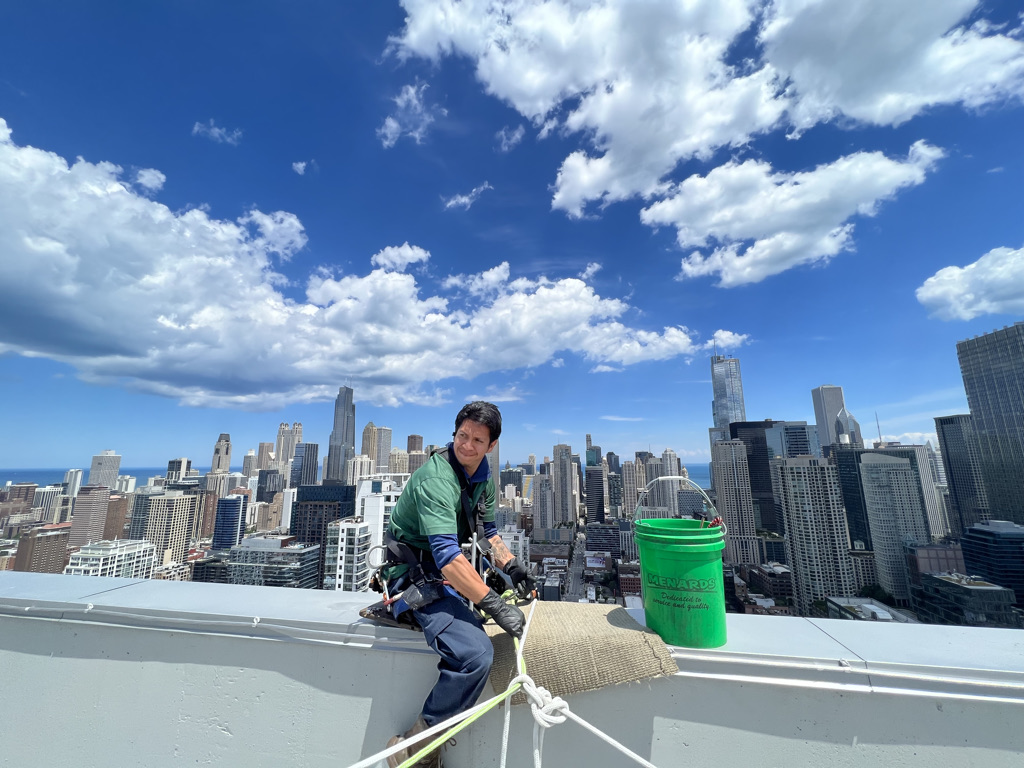Do you realize how vital it is to clean windows safely? It’s important to learn the proper safety practices, whether you’re a pro or just cleaning your own windows, especially when working on high-rise buildings.
Imagine being confident in your ability to perform your job securely, knowing that you have taken every possible precaution to prevent accidents and injuries. This invaluable knowledge safeguards you and enhances your professional reputation and competence.
This guide will address window washing safety, including crucial information, ideas, and methods to keep you and your crew safe while doing this vital task. From personal protective equipment to fall protection, we cover it all.
Don’t wait any longer! Read on to discover the secrets of window cleaning safety techniques that will help you transform your approach to this critical aspect of your work. The peace of mind and improved performance you’ll gain are well worth the time invested.
Personal Protective Equipment (PPE)
Contents
- 1 Personal Protective Equipment (PPE)
- 2 Gloves:
- 3 Safety goggles:
- 4 Hard hats:
- 5 Slip-resistant footwear:
- 6 Ladder Safety
- 7 Fall Protection
- 8 Frequently Asked Questions
- 8.1 Is it necessary to wear personal protective equipment (PPE) when cleaning windows?
- 8.2 What type of gloves are recommended for window cleaning?
- 8.3 How do I choose the right ladder for window cleaning?
- 8.4 How should a ladder be set up properly for window cleaning?
- 8.5 What types of fall protection systems are available for window cleaners?
- 8.6 How often should fall protection equipment be inspected?
Gloves:
The importance of wearing the right gloves for window cleaning cannot be overstated. Gloves protect your hands from cuts, abrasions, and chemical exposure, ensuring a safe and efficient cleaning process.
Opt for gloves made of materials that offer excellent grip and dexterity, such as nitrile or latex.
According to a study by the Bureau of Labor Statistics, hand injuries account for nearly 20% of disabling occupational injuries in the US, which highlights the necessity of proper hand protection (source: BLS).
Safety goggles:
Protecting your eyes is crucial when dealing with chemicals, debris, and potential high-pressure spray from window cleaning equipment. Safety goggles shield your eyes from harmful substances and reduce the risk of eye injuries.
The National Institute for Occupational Safety and Health states that over 2,000 workers suffer eye injuries on the job each day, and proper eye protection could have prevented up to 90% of these injuries.
Hard hats:
Wearing a hard hat is essential when working at a height or in an area where objects may fall.
Hard hats provide protection against impact, penetration, and electrical hazards, ensuring the safety of window cleaners in various environments.
The Occupational Safety and Health Administration (OSHA) mandates using hard hats for workers exposed to such risks.
Slip-resistant footwear:
Proper footwear can make all the difference in preventing slips and falls during window cleaning.
Slip-resistant shoes with proper traction and support help maintain balance on wet or slippery surfaces, reducing the likelihood of accidents.
According to the National Safety Council, slips, trips, and falls cause nearly 700 fatalities in workplaces each year. Therefore, investing in quality slip-resistant footwear is vital to enhancing safety during window cleaning tasks.
Personal protective equipment plays a pivotal role in ensuring the safety of window cleaning professionals. By choosing and using the right gloves, safety goggles, hard hats, and slip-resistant footwear, you can significantly reduce the risk of injuries and accidents on the job. Prioritizing safety protects you and your team and contributes to a more efficient and professional working environment.
Ladder Safety
Choosing the right ladder:
Selecting the appropriate ladder for your window cleaning tasks ensures safety and efficiency.
When choosing a ladder, consider height, weight capacity, and material (aluminum, fiberglass, or wood).
Each ladder type has its advantages and drawbacks, depending on the work environment and specific job requirements.
The American Ladder Institute recommends using a ladder with a duty rating that exceeds the combined weight of the user, tools, and materials.
Proper ladder setup:
Setting up your ladder correctly is a crucial aspect of ladder safety.
Always place the ladder on a firm, level surface, and ensure it is fully extended and locked into place before climbing.
Follow the 4-to-1 rule, which means for every four feet of ladder height, the base should be one foot away from the supporting structure. This helps to maintain stability and reduce the risk of tipping.
OSHA reports that about 20% of fall injuries involve ladders, emphasizing the importance of proper setup.
Climbing and working on ladders safely:
When climbing a ladder, maintain three points of contact at all times (e.g., two hands and one foot or two feet and one hand). This helps to ensure stability and minimize the risk of falling.
Additionally, avoid overreaching or leaning too far to one side while working, as this can cause the ladder to become unstable.
The National Safety Council states that 53% of ladder-related injuries occur due to overreaching.
Ladder maintenance and inspection:
Regularly inspecting and maintaining your ladder ensures its safe and reliable performance.
Check for any visible defects, such as cracks, corrosion, or loose components, and address any issues promptly.
The American Ladder Institute suggests thorough inspections before each use to identify and rectify potential hazards.
Ladder safety is a critical component of window cleaning safety techniques. You can significantly reduce the risk of accidents and injuries by choosing the right ladder, setting it up properly, climbing and working on it safely, and conducting regular maintenance and inspections.
Prioritizing ladder safety benefits you and your team and contributes to a more efficient and professional work environment.
Fall Protection
The importance of fall protection:
Fall protection is critical to window cleaning safety, mainly when working at heights.
Falls are one of the leading causes of fatalities and injuries in the workplace. According to the Bureau of Labor Statistics, in 2019, there were 880 fatal falls in the United States, accounting for 17% of all occupational fatalities.
Implementing proper fall protection measures helps reduce the risk of falls and ensures the safety of window cleaning professionals.
Types of fall protection systems:
Various fall protection systems can safeguard window cleaners working at heights. These systems include:
- Harnesses: Full-body harnesses distribute the force of a fall across the wearer’s body, minimizing the risk of injury. They should be used in conjunction with other fall protection equipment, such as lanyards and anchor points.
- Lifelines: Lifelines are flexible lines that connect the harness to an anchor point, allowing workers to move horizontally or vertically while remaining secure. They can be self-retracting, which helps to arrest a fall quickly, or fixed, providing continuous protection along a designated path.
- Anchor points: Anchor points are secure attachment points for harnesses and lifelines. They must be strong enough to support the force of a fall and positioned to minimize the potential fall distance.
Proper usage and maintenance of fall protection equipment:
Using fall protection equipment correctly and ensuring it is well-maintained is essential. This includes inspecting equipment before each use, checking for signs of wear or damage, and replacing defective components. Additionally, workers should receive proper training on using and caring for fall protection equipment.
OSHA states that falls can be prevented and lives saved through proper planning, training, and the use of appropriate fall protection equipment.
By understanding the importance of fall protection, selecting and using appropriate systems, and ensuring proper usage and maintenance of equipment, window cleaning professionals can minimize the risk of falls and create a safer work environment.
Prioritizing fall protection not only protects workers but also contributes to a more efficient and professional work setting.
Frequently Asked Questions
Is it necessary to wear personal protective equipment (PPE) when cleaning windows?
Yes, it is crucial to wear PPE such as gloves, safety goggles, hard hats, and slip-resistant footwear when cleaning windows. These protective gears help prevent injuries and accidents, ensuring a safe and efficient cleaning process.
What type of gloves are recommended for window cleaning?
Nitrile or latex gloves are recommended for window cleaning as they offer excellent grip and dexterity. These gloves protect your hands from cuts, abrasions, and chemical exposure, ensuring your safety during the cleaning process.
How do I choose the right ladder for window cleaning?
When choosing a ladder for window cleaning, consider the height, weight capacity, and material (aluminum, fiberglass, or wood). Each ladder type has its advantages and drawbacks, so choose one that suits the work environment and specific job requirements.
How should a ladder be set up properly for window cleaning?
To set up a ladder properly, place it on a firm, level surface and ensure it is fully extended and locked into place before climbing. Follow the 4-to-1 rule, which means for every four feet of ladder height, the base should be one foot away from the supporting structure. This helps maintain stability and reduce the risk of tipping.
What types of fall protection systems are available for window cleaners?
Some types of fall protection systems for window cleaners include harnesses, lifelines, and anchor points. Full-body harnesses should be used in conjunction with other fall protection equipment, such as lanyards and anchor points.
How often should fall protection equipment be inspected?
Fall protection equipment should be inspected before each use to check for signs of wear or damage. It is essential to replace any defective components immediately. Regular maintenance and proper training on equipment usage and care are essential to ensure worker safety.


